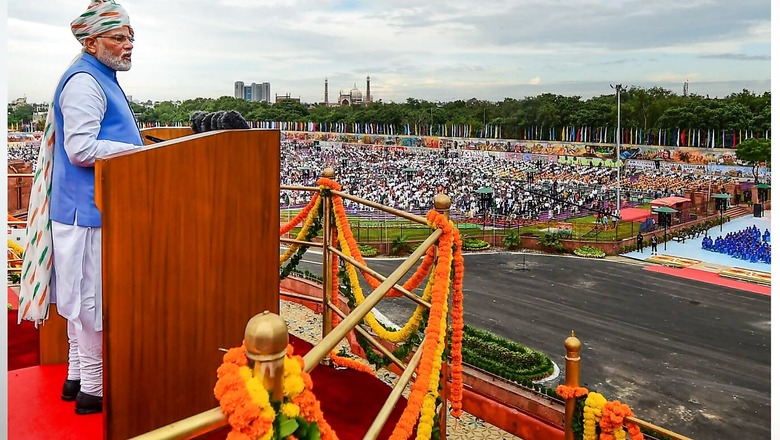
views
Prime Minister Narendra Modi’s Independence Day speech not only truly befitted the momentous occasion but also brought to the fore the fact that he was carrying forward the legacy of our freedom struggle in both word and spirit. The movement for Independence which witnessed supreme sacrifices by millions of Indians was aimed at not only political freedom but it was also a quest for selfhood.
The quest for this selfhood was forgotten under successive Congress regimes which modelled Bharat’s growth and development trajectory on Western paradigm. What we are witnessing under the Modi regime is the revival of this quest for self-hood.
Jawaharlal Nehru and Indira Gandhi’s obsession with socialism and Rajiv Gandhi, PV Narasimha Rao and Manmohan Singh’s obsession with market-driven capitalism left millions of Indians untouched as a select group of people reaped the benefits. The larger society was not part of India’s growth story till 2014.
Modi had realised this. That is why the first step he took immediately after assuming charge as ‘Pradhan Sevak’ was to open bank accounts of the poor. This financial inclusivity is the cornerstone of his government’s motto to ensure ‘Sabka Saath, Sabka Vikas.’ These accounts have proved to be the key tool to link all government schemes with the beneficiaries and hence bring them into the mainstream of economic development.
What the Prime Minister spoke from the ramparts of the Red Fort on 75th anniversary of our Independence carried two clear messages: One, we need to decolonise our mind set; and two, we need to work on a Bharatiya model of development and not a Western model. This is a giant leap towards finding and establishing that selfhood which turned Bharat into a nation that has been having an uninterrupted run since the beginning of the civilisation. The loss of this understanding about selfhood was the key reason that Bharat spent almost 1,000 years under the rules of invaders. Though the heroic resistance continued during these 1,000 years and this resistance was also driven by this search for selfhood.
What Prime Minister Modi did today was to define this ‘selfhood’ with great clarity and also unfold a roadmap for the next 25 years to realise this selfhood that would make India a developed nation.
Modi’s vision to make Bharat a developed country by 2047 as mentioned in his speech had already started unfolding ever since he took the reins of the nation in 2014. His clarion call to check nepotism, corruption and end the ‘dynast’ culture in all spheres of our social life has been preceded by actions in this regard.
The Prime Minister underlined some of the biggest systemic maladies when he pointed out: “Our many institutions are affected by family rule, it harms our talent, nation’s capabilities and gives rise to corruption.”
He further added, “It is our effort that those who have looted the country will have to pay back. In India, where people are fighting poverty, we need to fight against corruption with all our might.”
A significant point needs to be made here that makes the Prime Minister stand out as compared to his predecessors. While there has been a general tradition in Indian polity to make announcements and then they are followed by the action. Prime Minister Narendra Modi has reversed this trend.
He has already initiated substantial actions on both these fronts. The so-called high and the mighty who were at the helm of corruption have been put behind bars. Properties worth thousands of crores have already been confiscated by the government to realise the outstanding dues of various banks which apparently lend loans to many ‘big fish’ during the UPA regime. The strengthening of agencies like Enforcement Directorate and Central Bureau of Investigation and the professionals introduced in them as well as other anti-corruption government agencies during the last eight years is remarkable.
As far as the ‘dynast’ culture is concerned, neither in his government nor in his party, i.e. Bharatiya Janata Party (BJP), the Prime Minister had allowed this malady to exist. The old and obsolete ‘power structure’ that emerged during Congress regimes and proved to be detrimental to the country with one particular dynasty being at the helm of affairs has been replaced by ‘meritocracy’ during the last eight years. And the Prime Minister has given enough indications that
Five pledges for developing India by 2047
As mentioned above, PM Modi’s Bharatiya model of development is based on the five pledges he sought from people of the country. These five pledges are having a developed India, removing any sign of colonial baggage, pride in our heritage, unity and focus on our duties.
The Western paradigm which our country followed till now is based on colonisation and focus on our rights whereas Modi, bringing back the ancient Bharatiya tradition, has talked about giving precedence to duties. He is looking forward to building a dutiful nation and not a nation of right seekers. Modi also talked about another hallowed tradition of Bharat: Respecting women and girls in both the word and spirit by the society at large. According to our scriptures ‘Yatra Naari Pujyante, Tatra Ramante Devta’ (Gods live at those places where the women are worshipped). Feminism is inherent in Sanatan Dharma. In fact, our ancient traditions go beyond the Western concept of gender equality; Bharat has always considered ‘feminine’ to be more superior than masculine. The tradition of worshipping the goddesses is a manifestation of this deep understanding of the importance of women.
Prime Minister Narendra Modi’s vision for a developed India is an ominous signal for an aspirational society who has the capability and the potential to show the rest of the world a new model of development which is sustainable, brings greater equality and ends all kinds of conflicts. Hopefully, we can achieve this much before 2047 through our own Bharatiya model of development.
The writer, an author and columnist, has written several books. The views expressed in this article are those of the author and do not represent the stand of this publication.
Read the Latest News and Breaking News here














Comments
0 comment